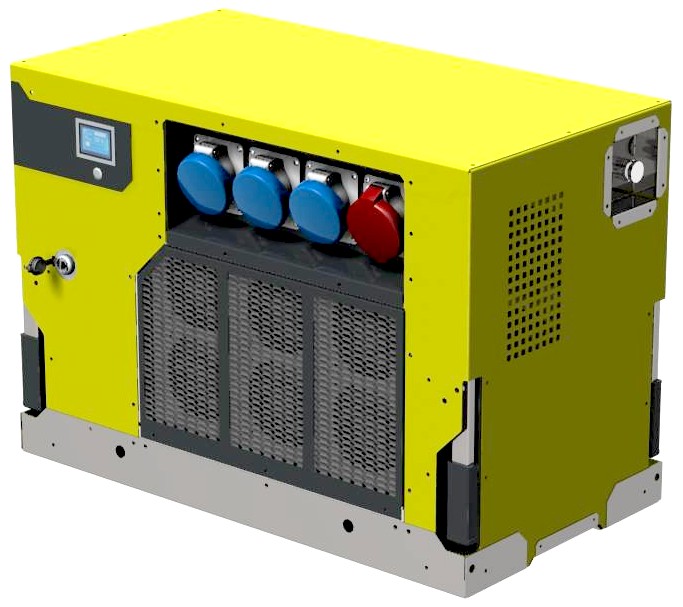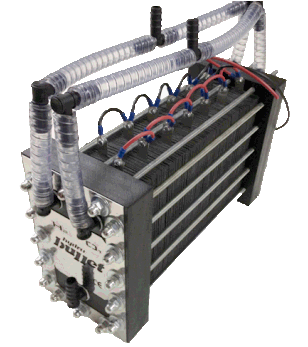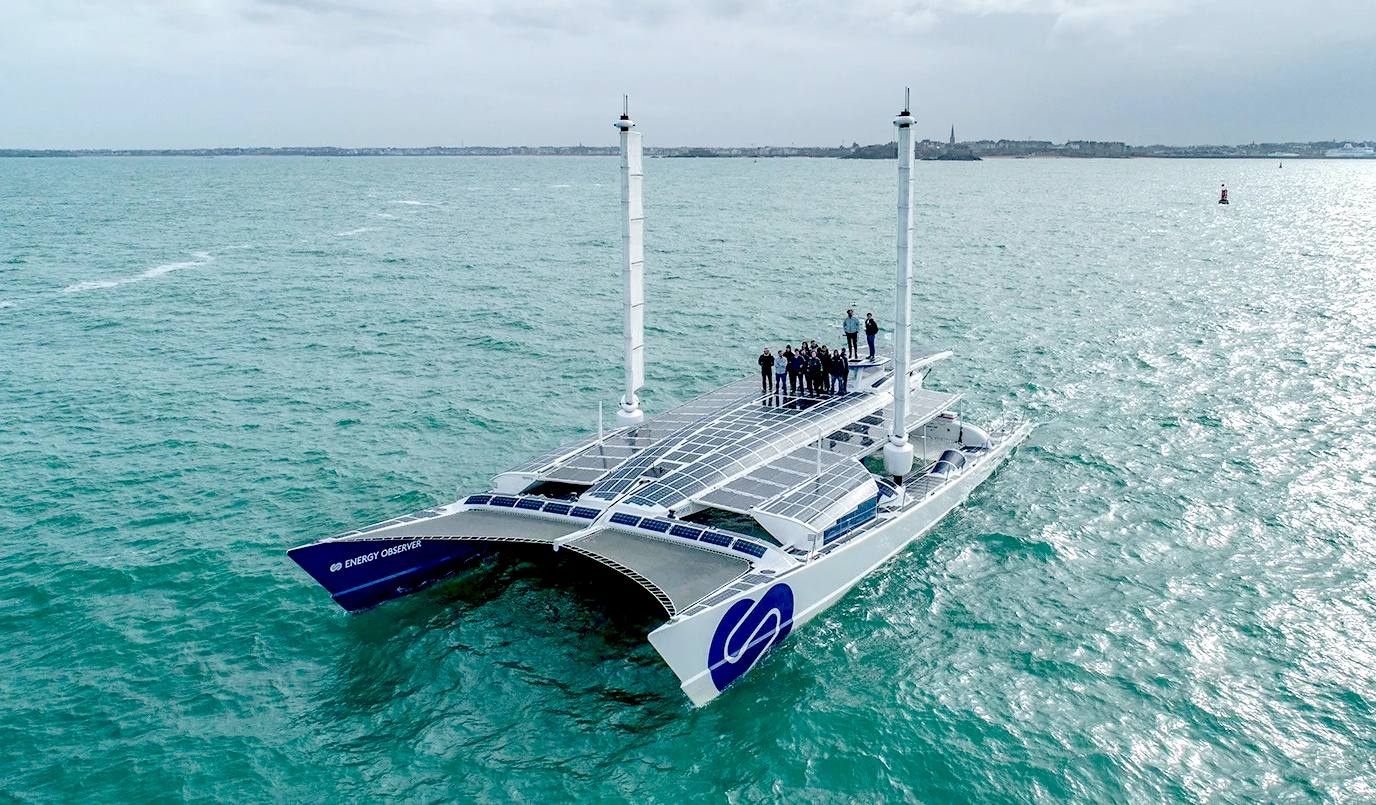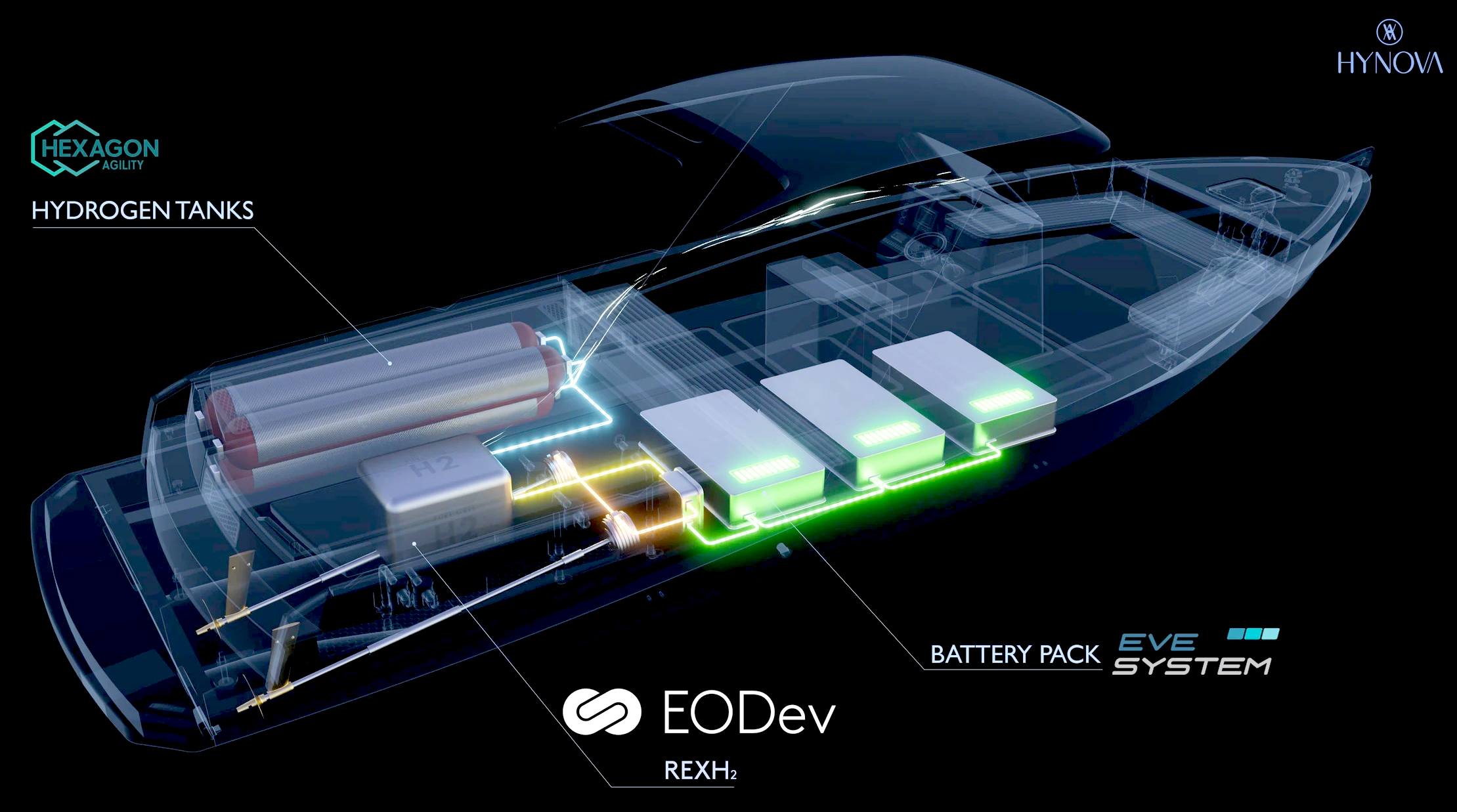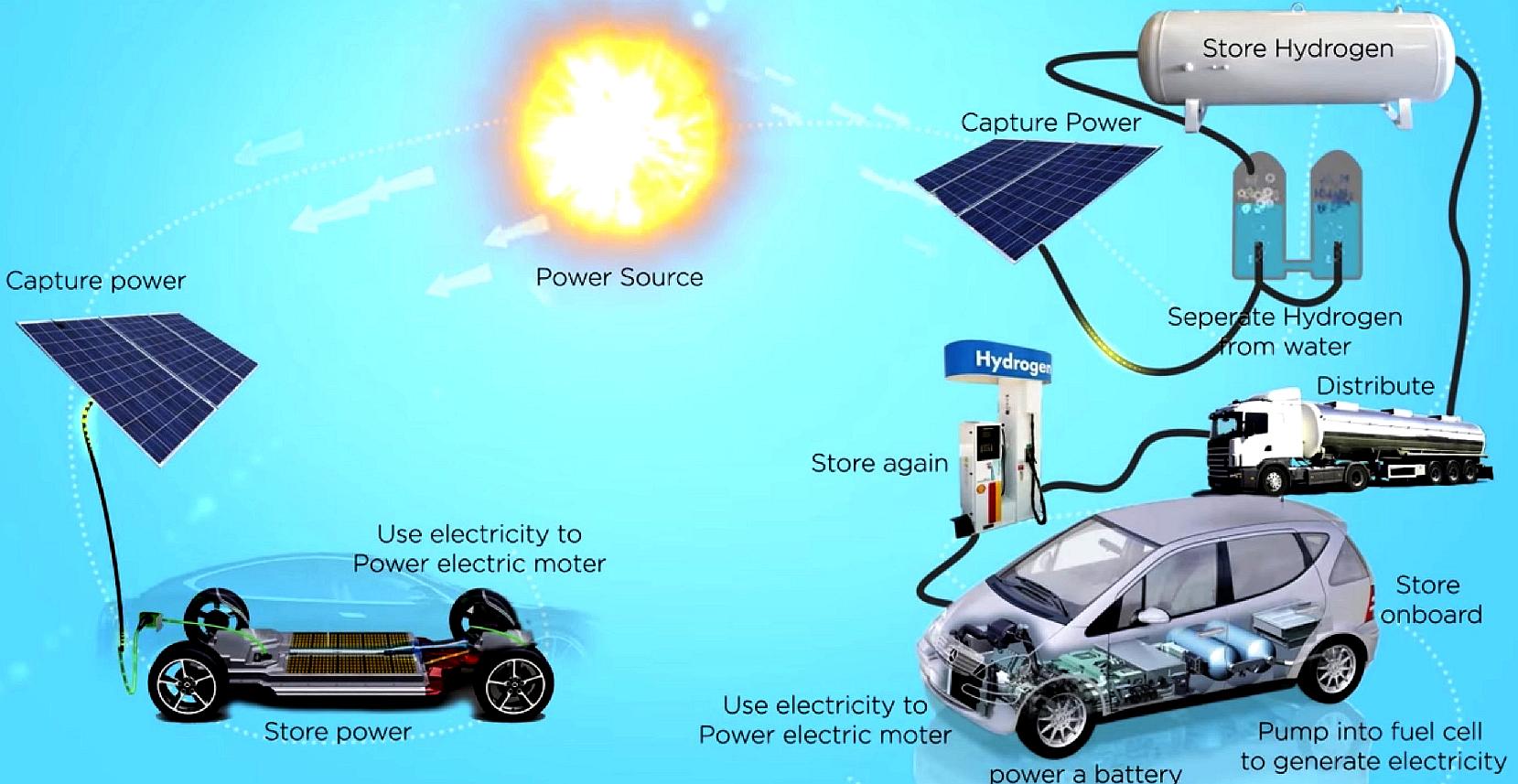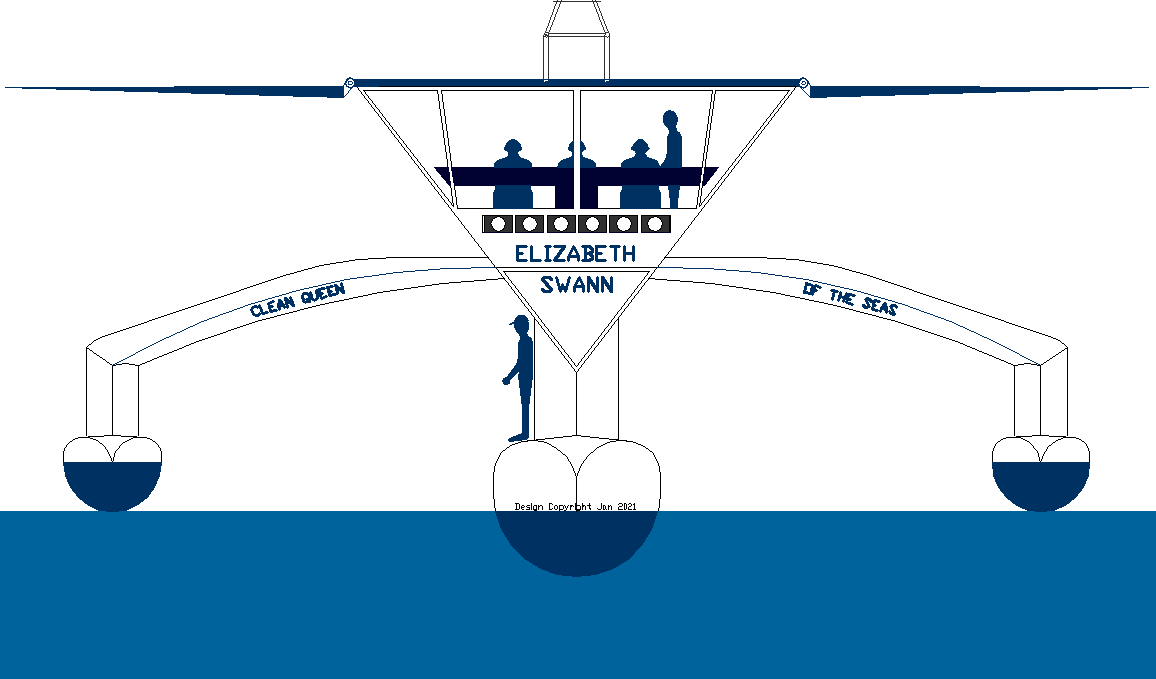|
HYDROGEN - ENERGY STORAGE
Please use our A-Z INDEX to navigate this site or return HOME
|
GENERATING HYDROGEN - Mobile hydrolyzer and fuel cell electricity generators in combination with onboard hydrogen storage, could be a range extending option for short and medium range vessels, such as ferries. The proposed combination could considerably reduce battery mass and cost for new vessels, as identified by Hynova and others.
When the Elizabeth Swann is moored in a harbour for longer periods, it is likely that the onboard lithium batteries will be fully charged quite quickly (depending on capacity), leaving energy that could be harvested from nature, with nowhere to go. After than time any energy generated by the wind turbine or solar panels will be wasted unless we can store it onboard effectively, as a reserve for use at sea.
Rather than opposing batteries to hydrogen as onboard energy storage adversaries, we consider they could be complementary technologies, to cope with solar and wind powered hybrid intermittencies. This proposal could be a true accelerator and incubator of solutions for a smart and optimized use of clean energy "mixes", combining different renewable energy sources, to include the mass storage of hydrogen as a range extender.
For the Swann, this may mean extremely fast crossings of the English Channel. But for larger craft designed along the same principles, and scaled up, it could mean Trans-Atlantic or even Trans-Pacific voyages. Using liquid hydrogen, a circumnavigation on a single tank full, is a possibility. First proposed on this site in July 2021
Aircraft had the same problem, overcome by the likes of Louis Bleriot, where he crossed the English Channel in July 1909, in his XI. The Channel was not such a big deal, but then Charles Lindbergh came along with his Sprit of St. Louis NYP in May 1927 - basically, a monoplane converted to a giant fuel tank, to cross the Atlantic from New York to, some 3,600 miles.
Commercial aircraft use their wings as integrated fuel tanks, killing two birds with one stone.
Instead of using commercially available cylinders with gensets like that pictured above, we are considering modifications to the hull to allow us to use stored hydrogen more efficiently than, for example, Energy Observer, and the New Era. The green hydrogen generated at anchor, would go to improving vessel performance when a ship is back at sea again. Ideal as a reserve, or for short hop vessels, to increase performance. It is cleaner than using a diesel backup, as on the Mayflower trimaran.
ENERGY OBSERVER - She started out with 21kW of solar panels, seen here with 34kW of sun packing power, but still has a power to hull displacement ratio of 1.14 kW/ton. That is an improvement on PlanetSolar's 1.05kW/ton, but nowhere near the 3kW/ton of the Elizabeth Swann. Oddly enough, PlanetSolar managed a higher average speed across the Atlantic, over the Observer. Suggesting that the energy conversion chain of the French yacht, is not as efficient as the large Swiss boat. Not wanting to be greedy, but we think we can improve on both of these magnificent achievements. For that is what they are; trail-blazing pioneers.
ENERGY OBSERVER - SUN, WIND & HYDROPOWER
Another vessel that is presently developing this theme as a range extending energy-storage solution, is the Energy Observer, a vessel that has an on board hydrolyzer, compressor and high pressure storage tanks that feed gas into a fuel cell, to make electricity for the electric motors. In 2020 Energy Observer crossed the Atlantic at an average of 4.4 knots, somewhat slower than PlanetSolar's 5.3 knots, but, as with all innovators, they are working to improve their technology. The Elizabeth Swann team are inspired by their efforts, learning from the Toyota/Observer teamwork, especially in the development of the REXH2 from their own experiences, then converting the Mirai car components, working with Toyota Europe. We hope to build on this pioneering work, with the developments we envisage for the unique hull-form of the Swann and the potential for mass storage of hydrogen gas, liquid and even ammonia (when such fuel cells are proven) to increase the potential of the Swann, that should be another step up for mankind, if the Swann manages to get anywhere near her target design figures.
That said, we have our fingers crossed for the crew of the Observer and may we all learn together, building on each other's achievements. They are using Toyota's REXH2 fuel cell - compressor – inverter set, boasting a maximum power of 60 kW, operated at around 50% of its potential to optimize its output. The problem being, that the hydrogen conversion chain is working against all of us, if generation is onboard, compared to battery storage alone.
HYNOVA, NEW ERA - You cannot get around battery or fuel cell mass (at the moment), but the space and weight of the hydrogen cylinders seen in the picture above, can be avoided if the hull is used to advantage. Unfortunately, most conventional designs are not so adaptable, hence, ship hulls that are proposed as suitable for hydrogen power, by the majority of naval architects, may not benefit from the proposed hydrogen range extending innovations for the Elizabeth Swann.
Electro-hydrogen hybridization is at the heart of the propulsion system of The New Era by HYNOVA Yachts, the first day-boat equipped with a REXH2® running on hydrogen and currently in approval phase. This is the brainchild of Frédéric Ménière, President of EVE System, Chloé Zaied, Managing Director of HYNOVA Yachts, and Romain Jallon, Director of Operations at EODev.
HYNOVA YACHTS - NEW ERA
On their New Era vessel, hydrogen is stored in carbon fiber tanks, under pressure (350 bars). The advantages compared to the other options are the same as found on board the Energy Observer boat: zero emissions (no CO2 or fine particles), silent, and greater density of power and energy than with an "all-battery" solution.
According to Hynova, the fuel cell provides the average power required to propel the ship, and the batteries will provide the peaks of power. This allows for intermittent power to the propellers of 300kW with a fuel cell of 60kW. The overall efficiency is improved because the battery thus operates at its optimum.
The hydrogen hybrid solution makes it possible, like a PHEV (Plugin Hybrid Electric Vehicle), to perform short services 100% electric on battery, and longer services, such as Cross Channel Ferries, with the energy supply of hydrogen.
The fuel cell and the batteries are connected in parallel to the voltage network supplying the motors. The Fuel Cell can only supply power, while the battery can supply power to motors or receive power from the Fuel Cell. The role of the batteries is to respond to calls for power from the motors, and to provide additional power to achieve maximum speed. The relatively short demands for speed are provided by the two sources together. Sizing the fuel cell to maximum power improves the compactness of the propulsion chain. A hybridization management algorithm optimizes the operation of the whole system.
On The New Era, they employ 250kW in battery power and 132kWh in energy storage. The battery is sized with respect to the average power required for the operation of the vessel.
Their battery packs were designed by Eve Systems, using Lithium-Iron-Phosphate technology. This offers lower energy density than Lithium NMC technology used in cars, but is more liable to thermal runaways leading to battery fires that cannot be extinguished. In discussions with Bureau Veritas on the certification of a hydrogen vessel, they advised Hynova against the use of NMC batteries, which they do not yet certify.
Design is a compromise. Automobile OEMs use NCA (Tesla) and NMC (all others). In heavy industries, and especially in boats, LTO and LFP are used for safety. LFP for energy density. LTO is for heavy usage, fast charging, but limited use - expensive and weighty. Hynova, use LFP, as per electric/hybrid work boats that sail in France. It's a reasonable solution to combine safety, performance and durability. Ref: Romain Jallon, Frédéric Ménière, and Chloé Zaied.
AUTOMOTIVE INFOGRAPHIC - Many readers will be familiar with this illustration of the energy conversion and supply chain for automobiles. At every stage of conversion or distribution, free energy from the sun becomes diluted, until it gets to the end user. Solar powered cars have been breaking the speed limits on Australian roads for years, during the World Solar Challenge. With all the losses associated with hydrogen, why should we bother with the extra complications? The answer is energy density, storage potential, and recycle-ability.
NOVEL HYDROGEN STORAGE SYSTEM
The Foundation are steering clear of overly compressing the hydrogen that is generated and storing in composite tanks, as with' Energy Observer' and 'New Era.' We intend experimenting with a novel idea that removes those percentage losses during the compression stage in the conversion chain to our advantage, better integrating hydrogen into the ship design - instead of bolting on later - with the aim of filing a patent at the appropriate time, by way of information dissemination. With all contributors sharing the IP.
The Elizabeth Swann has an ideal hull configuration for this purpose. No other vessel design that we know of is as suitable, as we write.
FRONT VIEW - In this CAD drawing the simple trimaran hull design lends itself to our purpose, proving that hydrogen vessels might ply our oceans. But like all technical challenges, until somebody does it, the trophy remains up for grabs. Please note, the latest Elizabeth Swann design is copyright © from June 2021, with all rights reserved.
It remains to be seen if there will be any real performance gains from such innovation and inclusion, after all the losses have been taken into consideration, even with the virtual elimination of losses in the compression stage used in the Energy Observer. All to be balanced against the additional displacement that we seek to avoid.
Though we considered using hydrogen batteries that are automotive (cartridge) compatible, the storage potential that we have identified negates what might have been a useful introduction of the technology to other smaller vessels, like an electric Riva speedboat and other water taxis, perhaps. In the case of the Swann, she would make her own hydrogen while at anchor and docked. In the case of larger vessels considering using hydrogen fuel cells, they will most likely be refuelled from shore based stations at ports with that facility. At least, those are the proposals. The Swann may of course fill with hydrogen while docked if an advantage.
For use as a ferry, the hybrid formula we are suggesting, we believe, has considerable potential, that is yet to be explored, as a ZEWT, or any other zero emission project.
|
|
PUSHING THE BOUNDARIES OF SCIENCE - The solar and wind powered 'Elizabeth Swann' will feature solar collectors and wind energy harvesting apparatus in an advanced configuration. She is seen here sporting a single VAWT electricity generator. Our mission is to mount a custom built vertical axis machine and test it, in relation to actual commercial routes.
|
|
A central wave piercing hull stabilized by outriggers as a trimaran including:
a) Ultra light superstructure purposed designed to harvest energy from nature via b) and c) below,
b) Solar wings that track the sun and fold for storms, in concert with
c) A turbine generator on a mast that tracks wind conditions and furls for storms.
The theoretical displacement we are working towards is: 30,000 - 45,000 kilograms (target) in 5083 marine grade alloy.
|
|
Please use our A-Z INDEX to navigate this site or return HOME
This website is Copyright © 2021 Jameson Hunter Ltd
|
